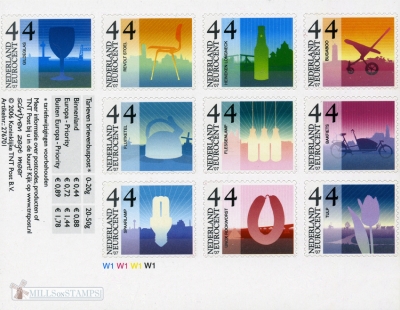-

Number by catalogue: Yvert: 2399 Scott: 1265e
Perforation type: 14 ¼x14 ¼
Subject:
44 cents. A kettle "Le Lapin" (Rabbit)*
On a background - silhouettes of two windmills (wind pumps)Additional:
* The kettle has been developed by Dutch designer Nikolai Carels. It represents Dutch firm HEMA, known worldwide, as the manufacturer of stylish and convenient subject matters of everiday life.
The kettle is the bestseller of the company more than 14 years.
-

Number by catalogue: Yvert: 2401 Scott: 1265g
Perforation type: 14 ¼x14 ¼
Subject:
44 cents. A Carrier Bike of factory Fietsfabiek*
On a background - a silhouette of Amsterdam and wind turbinesAdditional:
*Fietsfabiek - the family factory located in the center of Amsterdam.
Makes a many convenient models of bicycles, including many-placed and trading variants. To the buyers offer updating bicycles, on model with any quantity of places, addition of a box for a dog, carriages for children, or invalids.
-

Number by catalogue: Yvert: 2404 Scott: 1265j
Perforation type: 14 ¼x14 ¼
Subject:
44 cents. A tulip* on a background of a field with cows and a windmill (wind pump)
Additional:
*Tulipa, commonly called tulip, is a genus of about 150 species of bulbous flowering plants in the family Liliaceae. The native range of the species includes southern Europe, north Africa, and Asia from Anatolia and Iran in the west to northeast of China. The centre of diversity of the genus is in the Pamir and Hindu Kush mountains and the steppes of Kazakhstan. A number of species and many hybrid cultivars are grown in gardens, used as pot plants or as fresh cut flowers. Most cultivars of tulip are derived from Tulipa gesneriana.
Although tulips are associated with Holland, both the flower and its name originated in the Persian empire. The word tulip, which earlier in English appeared in such forms as tulipa or tulipant, entered the language by way of French tulipe and its obsolete form tulipan or by way of Modern Latin tulīpa, from Ottoman Turkish tülbend, "muslin, gauze".
It is unclear who first brought the Tulip to northwest Europe. The most widely accepted story is that of Oghier Ghislain de Busbecq, Ambassador from Ferdinand I to Suleyman the Magnificent of the Ottoman Empire in 1554.
By 1559, an account by Conrad Gessner described tulips flowering in Augsburg, Bavaria in the garden of Councillor Herwart.
the author of the first major work on tulips, completed in 1592. Clusius had already begun to note and remark upon the variations in colour that made the tulip so admired and his admiration of them quickly spread to others. While occupying a chair in the medical faculty of the University of Leiden, Clusius planted both a teaching garden and his own private plot with tulip bulbs. In 1596 and 1598 Clusius suffered thefts from his garden, with over a hundred bulbs stolen in a single raid.
Between 1634 and 1637, the early enthusiasm for the new flowers triggered a speculative frenzy now known as the tulip mania and tulip bulbs were then considered a form of currency. The Netherlands are still associated with tulips and the term 'Dutch tulips' is often used for the cultivated forms. Tulip Festivals are held in the Netherlands, Spalding (England) and in North America every May, including the Skagit Valley Festival (Washington), the Tulip Festival in May in Pella, Iowa, and the three week annual Canadian Tulip Festival in Ottawa, Canada. Tulips are now also popular in Australia, and several festivals are held during September and October in the Southern Hemisphere's spring.Now the tulip to the full is considered a symbol of Holland.
-

Number by catalogue: Yvert: C2395 Scott: 1265
Subject:
The booklet contains 10 various stamps with the most known products and inventions from the Netherlands.
Size (of sheet, booklet) mm: 109x85
-
2006-bklt-2-frgm-logo.jpg)
Number by catalogue: Yvert: 2405 Scott: 1266
Perforation type: 11x11
Subject:
72 cents. Clap skates* on a background of the Dutch landscape with a windmill (wind pump)
Additional:
*Clap skates (also called clapskates, slap skates, slapskates, from Dutch klapschaats) are a type of ice skate used in speed skating. Unlike in traditional skates where the blade is rigidly fixed to the boot, clap skates have the blade attached to the boot by a hinge at the front. This allows the blade to remain in contact with the ice longer, as the ankle can now be extended toward the end of the stroke, as well as for more natural movement, thereby distributing the energy of the leg more effectively and efficiently.
Clap skates were developed at the Faculty of Human Movement Sciences of the Vrije Universiteit of Amsterdam, led by Gerrit Jan van Ingen Schenau, although the idea of a clap skate is much older; designs dating from around 1900 are known.The clap skate was used first in the 1984/1985 skating season. It was, however, not until the late 1990s that the idea was taken seriously. In the 1996/1997 season, the Dutch women's team started using the skates with great success. The rest of the skating world soon followed suit, causing a torrent of world records to be broken in the following seasons, including the 1998 Winter Olympics in Nagano, Japan. Nowadays, all top level long track speed skaters (and many amateur enthusiasts) use clap skates.
-
2006-bklt-2-cover-logo.jpg)
2006-bklt-2-logo.jpg)
Number by catalogue: Yvert: C2405 Scott: 126a
Subject:
The booklet contains 5 identical stamps of 72 cents. Stamps are combined by thin perforating with labels of priority mail.
Size (of sheet, booklet) mm: 58x126
Made in Holland
Netherlands 2006.12.11
In issue: Stamp(s): 12 Booklet(s): 3
Printing: multicolor on self-adhesive paper
Issued in: booklets of 10 (first ten stamps of issue) and booklets of 5 (two last stamps)